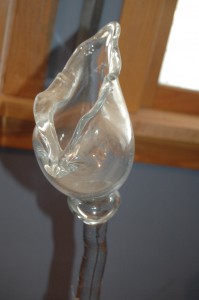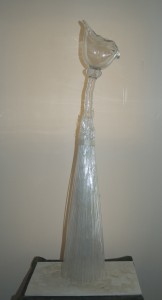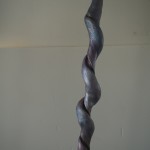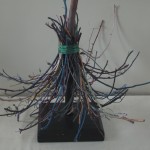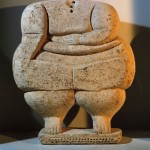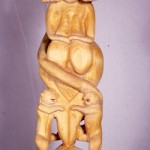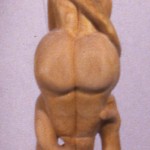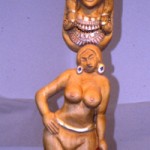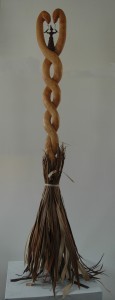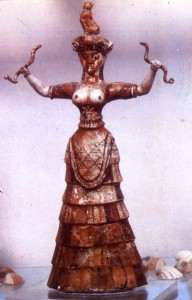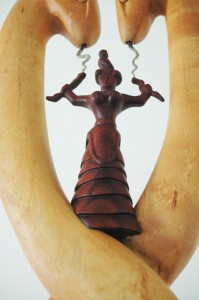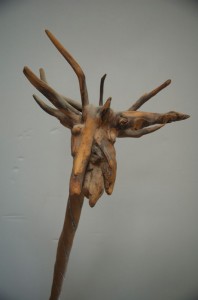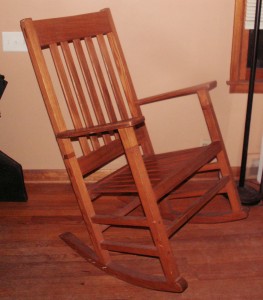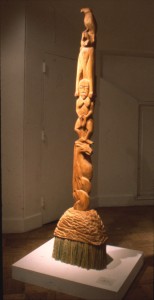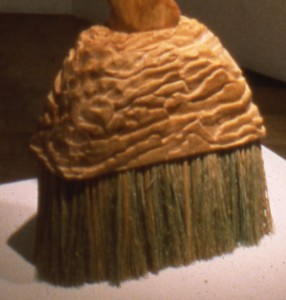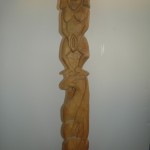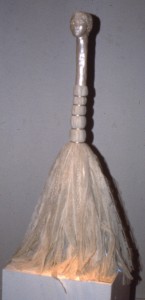
Click for larger image
Porcelain, Lace
This piece was inspired by the Cinderella story, and many other tales of with a female protagonist. Rae saw many of them with a common element, the story was told always from another’s point of view. The protagonist herself is silent, even silenced. Hence the woman with the long neck in this piece has no mouth. Her neck might even be elongated from the pressure of the things she wants to say but cannot.
This was one of the few pieces Rae tried in clay, though she used clay for the molds for some of her glass pieces. It is fired porcelain, with an iridescent glaze. The skirt is many, many yards of lace, which she was delighted to find in a bargain bin at a local fabric store just in time. This piece was claimed shortly after the Sweeping Changes show by Beverly Gordon, in whose collection it now resides.
From an interview by Amy Bethel, Rae had this to say about the piece:
…”
Yeah. um, from a lot of the things that were a challenge or traumatic about my early life. And I decided to make a broom that was called “In Honor of Cinderella.” And it’s a broom that’s made out of ceramic with over 500 yards of lace as the skirt. And it has a head at the top that’s very realistic, that Deb Trent helped me make. And it has a really long neck. The neck is about 3 feet long. And there’s no mouth. And the skirt–the lace skirt comes up and there are these seven little ribbons tied around the neck, as well as being [], and it’s done in a real light colored pearlescent fashion–I mean, glaze. And it’s real pretty, you know? In this sort of bizarre way. And what it is is–it is about the heroine that so many of us grew up with is this woman who never complains or shares her pain or talks about the abuse that’s been heaped upon her. She just holds it all in. So her neck just keeps getting longer and longer because there’s more and more stuff tangled up down there. And it never comes out because she has no way to speak it. And in essence that’s me, because in my early years there was a lot of pain and there were things that happened, and I was never allowed to speak them. You’d be told it didn’t happen, it isn’t true, you know , etc., etc., etc. And everything looks really pretty. You know, everything has that sort of white bread feel to it. That everything is chintz and lace and roses and it just wasn’t. You know? It just wasn’t. It was just swallowing it. It was just swallowing your pride, it was just holding back the words, it was just biting your tongue. And that piece was acknowledging that that is an experience that I had and that stories and media and Walt Disney and our parents and society as a whole really wanted me and everybody else to respect, love, cherish and buy the video of that victim. You know? And that was about healing. And that was about articulating that that’s what that piece was about. That culturally women are, you know, supposed to live these froufrou lives, but we don’t. That’s what we’re supposed to present to the world. And we don’t–you know, we don’t have that option to suddenly find a voice.”
And from her Master’s Thesis, Master Sweepings:
”
# 9 IN HONOR OF CINDERELLA
(ceramics, ribbons, lace)
Little voiceless victim, sweeping cinders. Dancing the ball with silent broom princes. Homage to voiceless women who survived. To loosening the silken bindings.
This piece was very problematic for me. I knew what I wanted to say and portray. I wanted to place Cinderella on a pedestal not as a princess, a woman (girl) worthy of attention by a prince and a fairy godmother. No, I wanted to honor and expose what I see as the secret truth of Cinderella Cinderella as victim.
For that is what she is. She is not just the victim of an “evil” stepmother and step sisters, but also of the brothers Grimm and of our culture. The brothers Grimm set down a version of a fairy tale in which a young girl seldom talks. She does not try to defend herself or even attempt to escape the abuse/situation. She is a “good” girl, who stoically waits for rescue, or relief or what death?
And our culture has picked up on this idea of the good girl waiting to be rescued. We’ve made myths, stories, movies of this archetype: whole theories regarding women’s powerlessness have been named for her. This is really interesting considering that the story theme in Cinderella is universal. Many countries and cultures have story themes of young women left alone and abused, but many of these stories reflect young women who run away, speak out about their abuse or refuse to be abused. Characters such a Caporushes and Tatergood are good examples of this alternative view. (need references here, further explanation) It has become apparent to me how much Cinderella’s voicelessness is like my own voicelessness as an incest survivor. The voice that could have let me save myself was cut off. The words that could have revealed the secrets were silenced. The challenge for me with this piece was how to make Cinderella recognizable and still portray her as a victim. The plan was to create a head on a stick a kind of puppet figure. This would symbolize the collection of unspoken words. The skirt would be made up of layers of lace fabric and bound with ribbons, symbolic of femininity, layers, tangled webs, Cinderella’s rags and her ball gown. The skirt would be wrapped with rings of ribbon to represent the acts and circumstances that had “caught” the words in her throat. Culture, life, abuse had all left their mark upon the victim.
I decided to make the stick out of clay. Not only is clay incredibly pliable, but it is both fragile and durable (fired clay can last for thousands of years). The surface of the clay is not smooth, it is banged up, it shows life experiences like a survivor. A clay face, the head of a woman who had survived, a tribute to survivors.
I made many heads that did not work. What I wanted to create was a face that had no mouth, to further represent the voiceless quality of Cinderella, and for this to be successful, it needed to be a realistic face. I wasn’t able to create a face/head that “read” well and that looked believable without a mouth; after three heads I was appalled at my creations, which ranged from abstract aliens to mouthless death masks. About this time the hand of fate stepped in. First a friend with skill to help me with ceramic realism moved to town, and second, all three of the heads in my studio were broken, probably by a tremor from the street.
I sought technical assistance from two ceramicists, Deb Trent, the friend, and Elaine Shear, Professor at the UWMadison. We discussed exactly what I needed, the symbology of the final piece and why I wanted things a specific way. Deb and Elaine were concerned by my desire to have the stick be one piece, and how would it survive the firing. With the input and work of the three of us,three new heads/handles began to materialize. The first head took on a coloring book appearance, with a long braid down the back becoming the broom stick. Another seemed too young, and did not have the eyes of a survivor. The third was very simple and smaller in scale, more like a fireplace broom. At first I was drawn to the coloring book piece, which I thought might be the most recognizable. But the third really gave me the sense of victim.
I designed and directed the faces, but Deb was instrumental in shaping them. I joined the faces to the stick, and then worked closely with Elaine on firing processes and glazes. The head needed to be very stable, and we created a number of sample tiles. I also had to create a specialized stand for this piece, one which had to be created while the clay was still wet and pliable. A stand of steel and wood was developed and the ceramic neck had a hole that allowed a long dowel to fit into the head.
I decided on lace ribbons rather than fabric for the skirt. Ribbons would allow for a closer association with broom, as well as reflect the tattered quality of Cinderella’s life and world. I wanted to portray the aspect of a spider web, the sense of trapped-ness. But lace has other qualities, it can also draw one in, people are fascinated and intrigued by it and how it was made. It can look soft and inviting and yet be scratchy. It has a tactile quality, in both feel and sound. The lace skirt in my broom thus draws the viewer in, and like a survivor, invites one into her space, shows her wish to be touched nicely, while at the same time the expresses her retreat due to fear and memory.
I used over 500 yards of lace, and over 100 yards of ribbon in the skirt. With the assistance of Melanie Herzog it was wrapped in five layers that got systematically higher and smaller.
The whole piece was a catharsis for me on many levels. This was an act of making something that honored me, my past, and the pain that many of us had experienced and survived. It also came at a time when I found out that my sister (a woman who lived Cinderella’s life fromsociety’s point of view) had been a victim of the same abuse I had experienced. And finally, the piece allowed me to experience my belief in art as a collective creative process.
I had worked with Judy Chicago on the Birth Project and, like many, experienced a great deal of disappointment and even loss. I loved the idea of women coming together, and I came into the project with a romanticized idea of a feminist art “quilting bee”, complete with process, political correctness and consciousness raising. For the most part I was disappointed, for it was not really a collective process.
Now I had the opportunity to work with women on my own piece, to thoroughly discuss the process, the piece, the motivation behind it, etc. I was not disappointed by the support and graciousness of my advisors. Each gave freely of advice, help, skills, knowledge, and talent. Each seemed clear on the collective process, yet aware of the integrity of the piece as mine, growing from my creativity. This experience allowed me to better understand the Judy Chicago experience, though I still had personal issues with Chicago’s style. Working with the Deb, Elaine, and Melanie was also not a feminist quilting bee, which is itself a romantic notion. It became one of those proverbial growing experiences, in which I learned more about the collective process of creativity, about art not being made in a vacuum, and about trust and generosity.”
 Sweeping Changes Series
Sweeping Changes Series